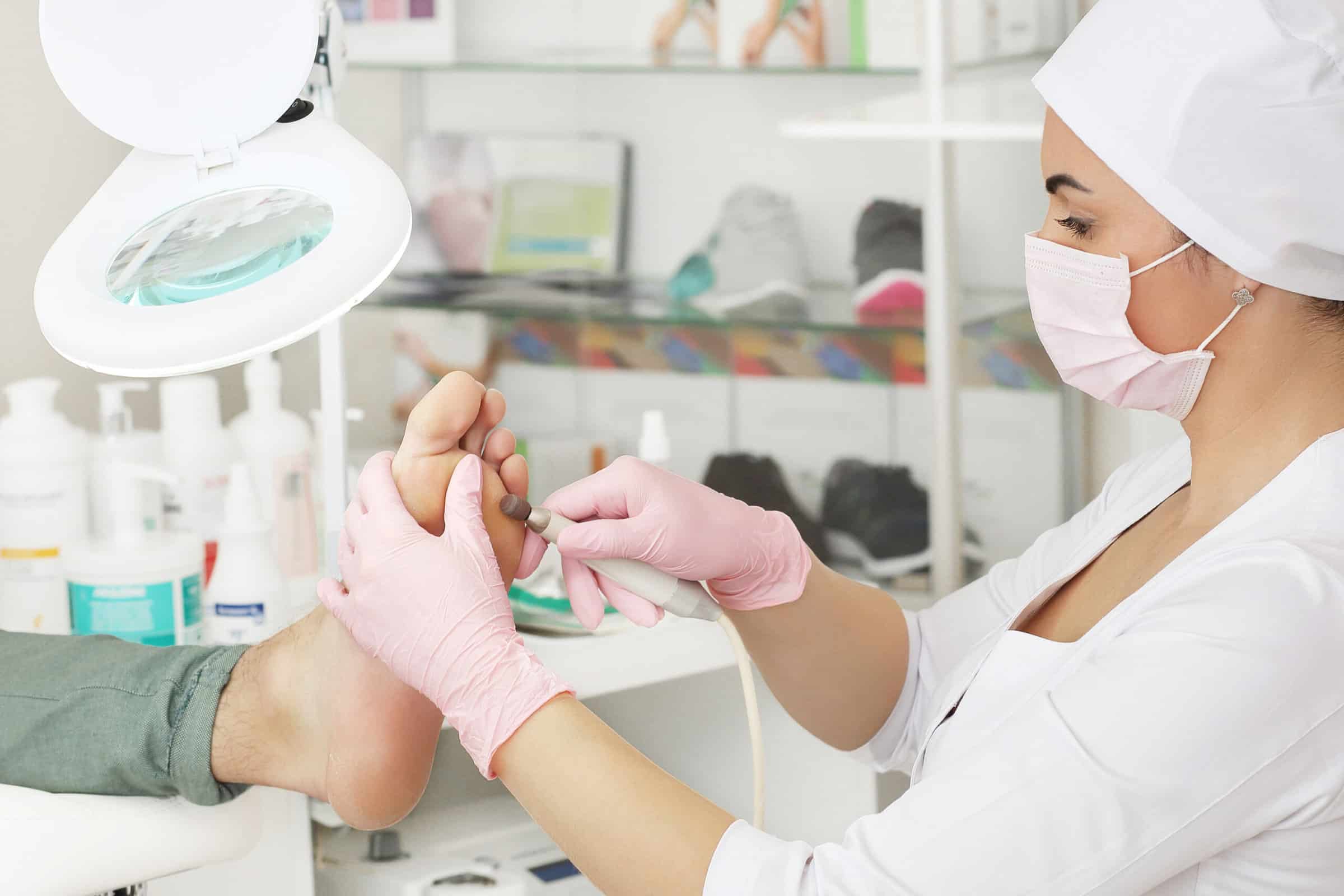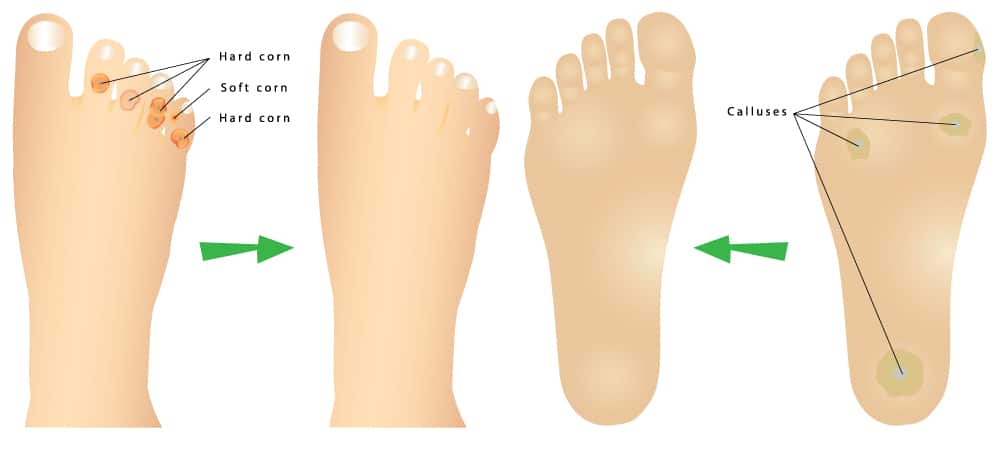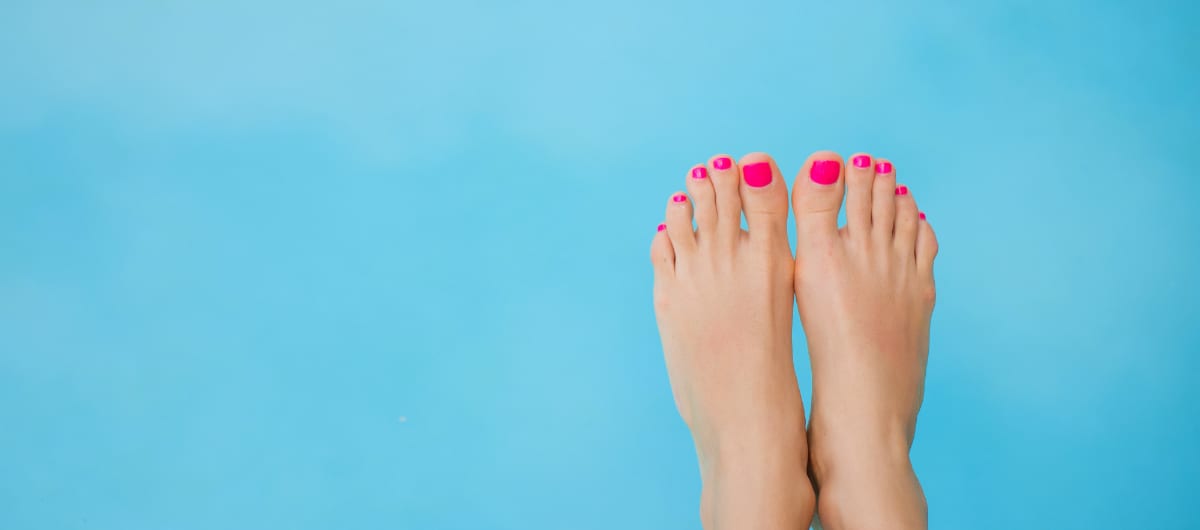Corns and Calluses
Corns and calluses are thick, hard, unsightly patches of compacted skin that form in response to repetitive friction or pressure.
They are one of your body’s natural defense mechanisms and are meant to protect the skin from more serious damage. However, they can be unpleasant, unsightly, and sometimes even painful.
They are also a sign that you may need to make some changes in order to reduce your risk of further complications—especially if you have diabetes.
What’s the Difference?
Corns and calluses are distinguished by their shape and location.
- Corns typically form in non-weight-bearing locations, particularly the toes. They tend to be smaller, shaped like a cone, and may feature a hard center core surrounded by softer, inflamed skin. They are more likely to be painful, especially when pressure is applied.
- Calluses typically form along the soles of the feet in weight-bearing locations, including the balls of your feet and the heels. They are usually long, flat, and rarely painful.
That said, both form the same way—repetitive pressure or friction on the skin.
What’s the Difference?
Corns and calluses are distinguished by their shape and location.
- Corns typically form in non-weight-bearing locations, particularly the toes. They tend to be smaller, shaped like a cone, and may feature a hard center surrounded by softer, inflamed skin. They are relatively more likely to be painful, especially when pressure is applied.
- Calluses typically form along the soles of the feet in weight-bearing locations, including the balls of your feet and the heels. They are usually long, flat, and rarely painful.
That said, both form the same way—repetitive pressure or friction on the skin.
Are Corns and Calluses Dangerous?
For most healthy people, the answer is no. If they are not painful and not bothering you, you may not feel treatment is necessary.
However, you should seek treatment if:
- Your corns or calluses are causing pain
- You have diabetes, peripheral vascular disease, or any other condition that causes poor sensation or blood flow to the feet. These conditions put you at elevated risk of developing more serious complications, including foot ulcers.
How Do I Get Rid of Them?
Most corns and calluses will go away on their own if you remove the source of friction or pressure. Usually, this involves wearing better shoes and socks that are more breathable, fit your feet better, and give your toes enough room to wiggle. Using moisturizer regularly may help as well.
If you have diabetes, or peripheral vascular disease your corns are causing you pain, or you just can’t seem to get rid of them, give our office a call so we can make a full evaluation and offer additional treatment methods.
Sometimes your corns or calluses are related to a problem with the bony structure of your feet that needs to be corrected. In other cases, we may help you safely trim your corn or callus, or protect it using moleskins or padding.
Never attempt to treat your corns or calluses at home by cutting them, using medicated pads or solutions, or other “home remedies.” These methods can easily damage healthy skin, or even lead to an infection. It is much better to have your feet treated in a safe environment, by foot specialists who know what they are doing.
Need help with your corns or calluses? Call Trinity Foot Center in DeSoto, TX today at (972) 293-9650.
Corns and calluses is the topic. What are corns and calluses? Corns and calluses are thickened tissue on top or on the bottom of the skin on the foot. It can be on top of a toe, it can be on the bottom of the bone, it can be on the side, it could be on the heel, but it’s thickened tissue that makes it very uncomfortable to walk. What causes it? Most people suffer with corns or calluses because they’re wearing shoes that aren’t properly fitted. Sometimes they’re just in a shoe that doesn’t have enough room in the toe box. Sometimes they’re in a shoe that’s poorly made. Sometimes it’s because they actually have a deformity of the of the toes or the bones in the foot, and it’s causing excessive pressure in a certain point, or certain area, and then you get this thickened tissue that makes it difficult to walk. The best way to treat it is how many people are already treated it. They find a way to use a puma stone, they moisturize, they change shoes, they put pads, all of these will work. If it’s not working, then it may be a more serious issue and it may need to be addressed with the actual deformity in your foot. So, if you’re dealing with any of these issues, and you’ve tried all of your home treatments, it’s time to see a specialist! Come and see us here at Trinity Foot Center, where we’ll examine you, maybe take x-rays, and find out if it needs to be surgically corrected, or whether there’s a treatment program we can put you on to resolve all of the pain in your feet, even sometimes to just different shoe gear. So, look forward to seeing you here at Trinity Foot Center, where we help to keep Texans on their feet.
Contact us
Office Hours
| Monday | 8:00am - 4:30pm |
| Tuesday | 8:00am - 4:30pm |
| Wednesday | 8:00am - 4:30pm |
| Thursday | 8:00am - 5:30pm |
| Friday | 8:00am - Noon |
Contact
p. (972) 293-9650
f. (972) 291-2533
Location
1801 N. Hampton Road
Suite 340
DeSoto, TX 75115
Inside the Inwood National Bank Building on the 3rd Floor
Request appointment
© Trinity Foot Center. All Rights Reserved. | Privacy Policy



